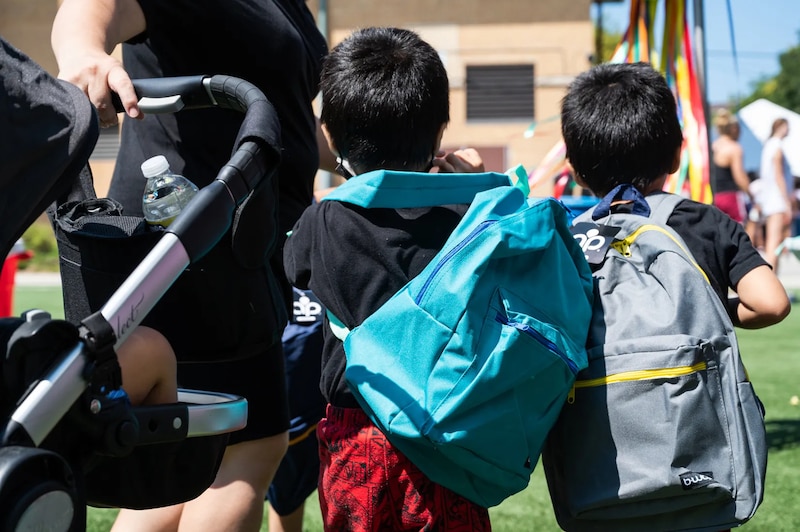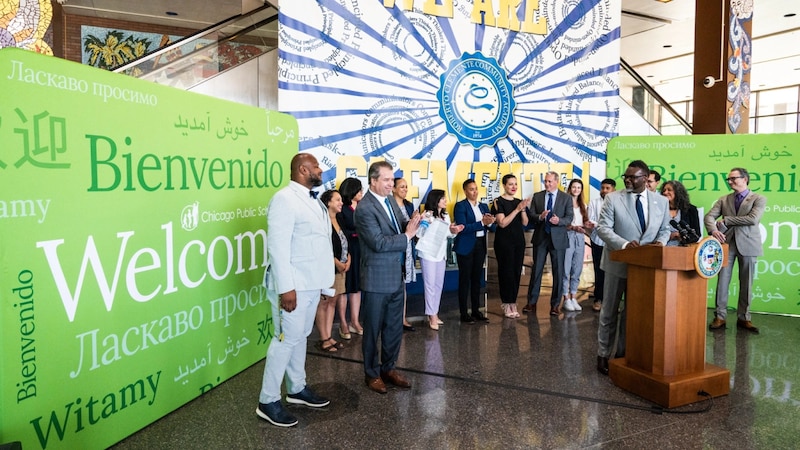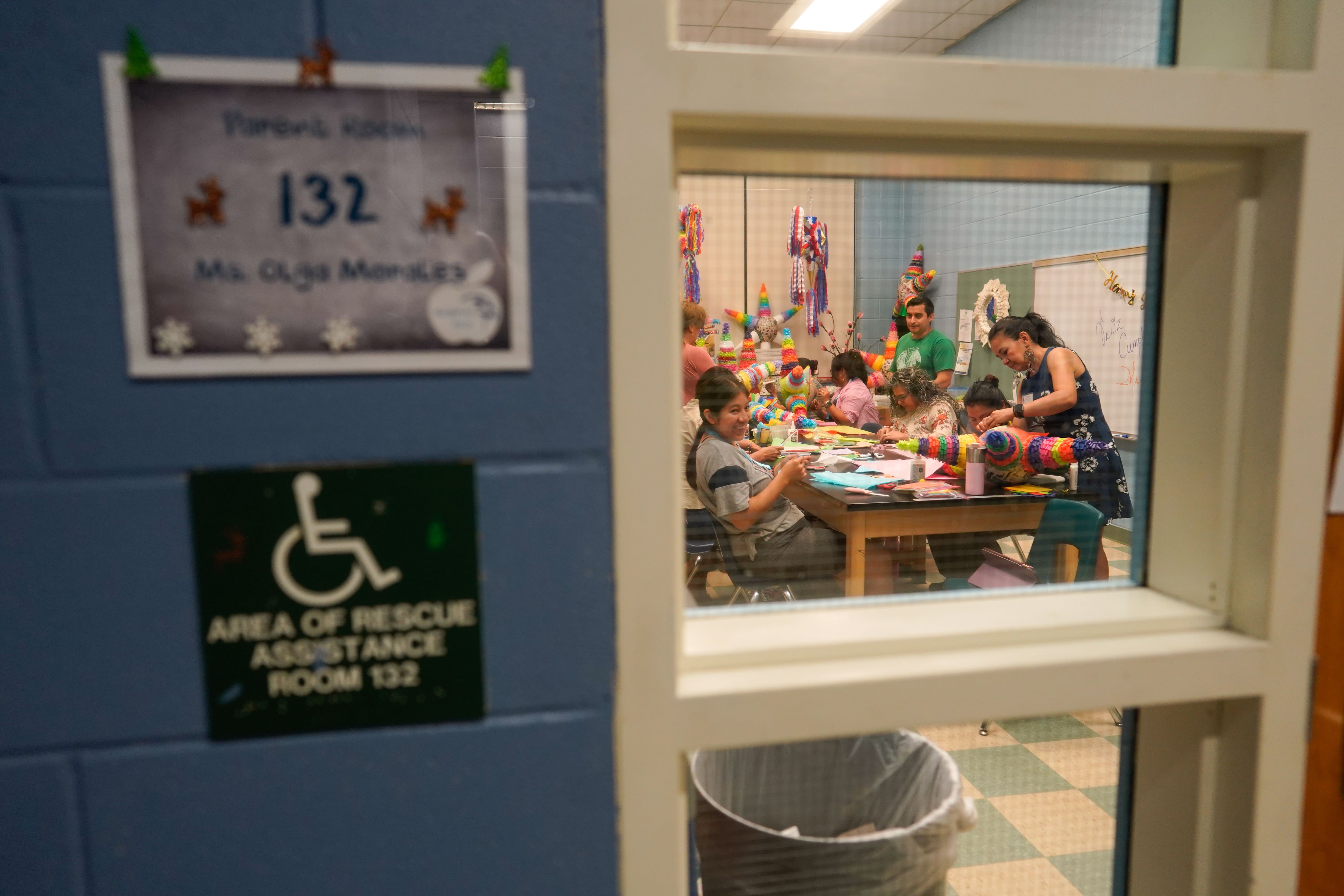¿Mami, estamos en casa?
That’s what Baltazar Enriquez heard last year as he passed out food to migrants at Union Station: The question came from a toddler: “Mommy, are we home?”
“I was about to give her some apples,” he said. “Her question just hit me. It dawned on me — I said the same question to my mom when I arrived.”
The moment of déjà vu brought Enriquez, president of the Little Village Community Council, back to when he was 3 years old and migrating from Mexico to Chicago.
“The answer was the same: ‘Yes, we’re home,’” Enriquez said. “So now that they’re here, they’re making Chicago home, how do we assist them to make sure they understand the system?”
That toddler was just one of thousands of new immigrants arriving in the city. Last August, Texas Gov. Greg Abbott started busing migrants to Chicago and other sanctuary cities, a move that some Democrats, including Illinois Gov. J.B. Pritzker, called a political stunt. Since then, more than 12,000 migrants, many of them asylum-seekers, have come to Chicago.
Chicago Public Schools did not say exactly how many migrant students have joined the district. However, CPS saw an increase of just over 5,400 English learners during the course of last school year, according to district enrollment data obtained by Chalkbeat.
Gabriel Paez, who first started working in the district a decade ago, said he’s never seen an influx of students at this level. He currently works as a bilingual coordinator at a Humboldt Park elementary school and is chair of the Chicago Teachers Union Bilingual Education Committee.
“We need to treat it with the urgency that it deserves,” he said. “Teachers who are trying to prepare for the upcoming school year really need to be ready for the onslaught to continue.”
In a statement, a CPS spokesperson said the district works with every student to “identify support needs regardless of country of origin.” But multiple teachers and immigrant advocates say many students are stuck without adequate resources.
Ahead of the coming school year, Chalkbeat Chicago analyzed enrollment and staffing data to examine the learning landscape for these kids. Here are the takeaways.
English learners increased by more than 5,000 students last year
The district determines English learners by screening students who come from non-English-speaking homes for their English proficiency. The increase of English learners bucks the overall trend of declining enrollment in CPS.
Last year’s increase brought the total number of English learners in the district above 77,000 as of June 7, the last day of the 2022-23 school year. Based on that data, English learners are nearly a quarter of the total student population in CPS.
It’s difficult to know how many students are recently-arrived migrants. District officials note that some students may migrate and already speak English; other students may speak a language other than English and are classified as English learners without having recently migrated to Chicago. So the increase of English learners doesn’t necessarily reflect the actual number of migrant students, but it can offer an estimate of the size of that population.

Once a school enrolls 20 or more students with the same language background, state law requires the school to implement a Transitional Bilingual Education program. Full-time TBE programs require educators to teach core subjects in both English and the native language of those students. The school must also provide instruction of English as a second language.
The state monitors bilingual programming to determine whether each school meets requirements. A WBEZ analysis in 2020 found over 70% of schools’ bilingual programs fell short based on the district’s own evaluations.
But it’s complicated to square the data on English learner enrollment with the number of staff actually providing bilingual education.
Designated bilingual teachers decline, but bilingual endorsements grow
Paez, the CTU Bilingual Education Committee chair, said schools may have staff that can speak with and support English learners, but that’s not a substitute for a bilingual program. Over the last year, he said, many schools have been operating on an emergency basis to address students’ needs.
“It can help a kid who needs translation or a kid who needs help transitioning from one classroom to the next or learning the school building,” he said. “If we have miscellaneous employees who aren’t certified teachers who are coming into classrooms and expected to be the way that child gets to participate, it doesn’t do right by the child.”
To teach students in their native language in a TBE program, a teacher must have a bilingual endorsement, according to an Illinois State Board of Education spokesperson. Another endorsement – in English as a second language — allows a licensed educator to teach English to non-native speakers, said the spokesperson.
A Transitional Bilingual Education program must do both — teach students in their native language and teach them English.
A review of publicly available and internal staffing data shows a mixed bag in Chicago Public Schools. The number of teachers designated as bilingual teachers has declined since 2015.
But not all educators who provide bilingual instruction are designated as bilingual teachers in CPS staffing data, according to the district. This analysis also doesn’t include charter and contract schools, as the district does not track their full staffing data.
Most of that decrease comes from a drop in the number of part-time bilingual teaching positions, according to a Chalkbeat data analysis.
Meanwhile, more than 6,000 teachers have endorsements in bilingual education or English as a second language (ESL) as of October 2022.
Educators can earn these endorsements through coursework and teaching experience. Bilingual endorsements also require the teacher to earn a degree in a language other than English or pass a language proficiency test.
However, it’s not clear which of these teachers actively use their endorsements in the classroom setting.
The number of teachers with endorsements has been on the rise in recent years. The district partially subsidizes the cost of ESL and bilingual endorsements, which is a provision in the Chicago Teachers Union’s current contract.
Ben Felton, chief talent officer for CPS, said the district aims to continue increasing teachers with endorsements.
CPS also uses its Teacher Residency program to train bilingual teachers over a one-year period, bringing in people changing careers or CPS staff wanting to move into a teaching position.
“Our Teacher Residency program is our most surefire way to invest in bilingual staff to make sure they become bilingual teachers,” Felton said. “We also felt this sense of urgency this year, knowing that there are newcomers that we need bilingual talent and we’re investing in that way.”
There also might be staff at schools who can speak a different language, but have none of these titles or endorsements.
Bilingual services vary by school and language
The most recent wave of people migrating to Chicago primarily come from Venezuela, where an economic and humanitarian crisis has driven millions out of the country. The official language of Venezuela is Spanish — but students are walking into schools with a variety of language and cultural backgrounds.
So even in neighborhoods with more Spanish-language resources and schools with more bilingual staff, there are challenges, said Enriquez, the organizer in Little Village, a predominantly Mexican-American neighborhood.
For example, he said, some recent migrant students speak Kʼicheʼ, a language spoken by some Indigenous people in Guatemala, and must navigate school without much support. Paez also pointed to students coming in speaking Kichwa or Quechua, the most-spoken Indigenous language in the Americas.
The state also requires bilingual programs to teach students about the history and culture of their homelands. That kind of curriculum is crucial, said Andrea Ortiz, director of organizing for Brighton Park Neighborhood Council.
“As a district, we have to figure out ways to invest and listen to our teachers and incorporate them in creating culturally relevant curriculum that speaks to the increase of families that are moving in,” she said. “A lot of the families that are coming are from Venezuela, and there’s huge cultural differences from Venezuelans and other Latinos that are here.”
Translating curriculum can be an issue too. The district’s optional universal curriculum Skyline currently has pre-K-8th grade courses in social science and world history translated into Spanish. CPS plans to roll out math courses in Spanish later this month. This fall, the district said CPS will begin developing Spanish language arts courses.
But that doesn’t address every students’ learning needs, said Kathryn Zamarron, a music teacher in CPS.
“We don’t have it in Urdu, in Arabic, in Amharic, in Vietnamese,” she said. “It’s not even enough in Spanish.”
CPS full-time substitute teacher Rebekah Amaya said bilingual services are needed for children recently arriving, but will also help other students. They work at a school in Brighton Park, a neighborhood that is predominantly Hispanic and Latino on the Southwest Side.
“It’s going to benefit the students that have already been lacking in those resources for a really long time, especially here on the South Side,” they said. “This just creates more of a catalyst for us to work harder to improve and increase our bilingual services.”
Trauma support and mental health services needed
Amaya said schools can be more than a place of learning – they also are a way for students to connect with social support, such as free meals and health services. They volunteer at the 9th district police station, and they said that overwhelmingly, parents are hoping for their children to get mental health care in schools.
But Amaya also said not every school has enough resources to meet that need, so enrollment plans need to be intentional.
“In the long run, it’s going to be more beneficial to the students and their environment and their mental health to send them to schools that can receive them and do have those services for them,” Amaya said.
In the past few years, CPS has doubled the number of social workers and budgeted for over 630 social work positions in the most recent public staffing file. The district also allocated $13 million in new funding for school nurses, social workers, and case managers in its fiscal year 2024 budget.
But according to a Chalkbeat analysis of the list provided by the district showing teachers with endorsements in August, only one social worker has bilingual or ESL endorsements. About 5% of the district’s 800-plus counselors and 28% of roughly 250 case managers have bilingual or ESL endorsements; some may have both.
Migrant students legally entitled to enrollment, but can still face instability
This summer, CPS launched a pilot welcome center at Roberto Clemente Community Academy, open to migrant students living in the West Town and Humboldt Park neighborhoods. Families can get their students enrolled in CPS, as well as connect with medical care, language support, and transportation resources.
That welcome center is a step in the right direction, said Amaya. But they said so many more neighborhoods need those services. They said mobile enrollment teams could be a good solution, especially given the housing and transportation challenges that families face.
“A lot of families have had to travel on like two or three buses – multiple hours – just to get to a job or just to get to a health care location,” they said. “It’s more important to meet families where they’re at and make that a little bit easier for them.”

CPS works with the Illinois Department of Human Services and the Department of Family and Support Services at shelters to coordinate enrollment for some students in shelters and hotels, according to the district.
But for families sleeping on police station floors and in shelters, unsure of when they might live permanently, enrollment in school can be daunting. A question looms: What happens if they enroll in a school and then move across the city or even out of Chicago?
Under federal law, students in temporary living situations are legally entitled to enroll even if they lack the required paperwork, such as proof of residency or health records.
Once a child is enrolled, they are also entitled to stay enrolled in the same school for the entire school year and receive transportation, even if they move.
But staying in the same school might not be practical for all students. Zamorran, the music teacher in CPS, also volunteers at police districts on the South Side, and she said the constant threat of movement takes a toll on students. The thought of ultimately transferring a child — after the long journey they’ve endured and finally settling them into a school — can be a painful one, she said.
“There’s this great question of: ‘Is this another trauma to my child,’” she said. “To…tell them: ‘This is your community and you belong here,’ and then take them from there?”
There’s a need for education, resources, and housing — but, advocates say, there’s also a need for a home.
Enriquez — the organizer in Little Village — remembers how important that feeling of home was when he moved from Mexico to Chicago as a kid. So Enriquez said he and other organizers will continue putting pressure on the district and the school board to give newcomers enough resources and support.
“We’re gonna fight to make sure we get a quality education, we get equal racial representation,” Enriquez said. “And if we’re not invited to the table, we’re bringing in our folding chairs.”
Max Lubbers is a reporting intern for Chalkbeat Chicago. Contact Max at mlubbers@chalkbeat.org.
Kae Petrin is data and graphics reporter for Chalkbeat. Contact Kae at kpetrin@chalkbeat.org.






